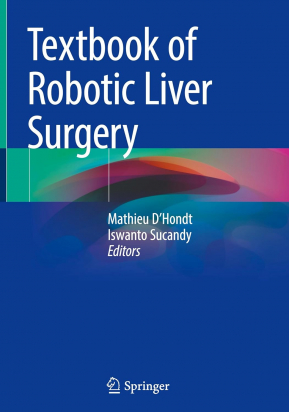Non ci sono recensioni
DA SCONTARE
After an initial slow diffusion of minimal invasive approaches in liver surgery, laparoscopy has now been implemented worldwide. This process has been sped up after several papers showed the superiority of laparoscopy over the open approach with regard to short-term outcomes. Before, the adaptation and diffusion of LLS was much slower compared to other general surgical specialties. The challenge in controlling major hemorrhage, the risk of gas embolism, the steepness of the learning curve and the uncertainty about oncological outcomes were barriers for the implementation of LLS. Nowadays, laparoscopic liver resections (LLR) are considered safe and feasible. The same evolution is seen in the diffusion of robotic liver surgery (RLS). The first reported robotic liver resection was published in 2003. Introduction of RLS has remained very slow compared to other subspecialties. This could be attributed to the complexity of minimally invasive liver surgery and the steep learning curve to overcome. Furthermore, the absence of instruments for parenchyma transection appeared to be a barrier for many surgeons to start RLS. Nowadays, Robotic liver surgery is in it's pioneering phase and limited to a few high volume centers. Furthermore data regarding the implementation of RLS are still scarce and the reproducibility of the implementation is still debated. This textbook will offer readers a useful overview of RLS state of the art, collecting the contributions of renowned robotic liver surgeons from Europe, Asia and the Americas. The editors will collaborate with a professional medical illustrator specialized in minimal invasive liver surgery to offer readers a visual experience of the most important surgical steps.
-
Front Matter
Pages i-xi
-
Introduction
-
Front Matter
Pages 1-1
-
Minimally Invasive Liver Surgery: Where Are We Now?
- Mohammad Abu Hilal, Jasper P. Sijberden, Tijs J. Hoogteijling
Pages 3-14
-
History and Worldwide Diffusion of Robotic Liver Surgery
- Rubén Ciria, Rafael Calleja, Javier Briceño
Pages 15-22
-
-
Robotic Systems, Patient Preparation and Anesthesia in Robotic Liver Surgery
-
Front Matter
Pages 23-23
-
Robotic Systems, Equipment, Instrumentation, and Troubleshooting
- Jeroen Hagendoorn
Pages 25-33
-
- Luca Chiarella, Riccardo Memeo
Pages 35-40
-
Anesthesia for Robotic Liver Surgery
- Pieter Jan Steelant
Pages 41-52
-
-
Different Approaches in Robotic Liver Surgery
-
Front Matter
Pages 53-53
-
- Francesca Ratti, Marco Catena, Luca Aldrighetti
Pages 55-61
-
Different Approaches in Robotic Liver Surgery: Pure Robotic Approach
- Mathieu D’Hondt, Edward Willems
Pages 63-68
-
-
Learning Curves and Training in Robotic Liver Surgery
-
Front Matter
Pages 69-69
-
Learning Curve in Robotic Liver Surgery
- Michelle M. Dugan, Sharona Ross, Iswanto Sucandy
Pages 71-75
-
Training in Robotic Liver Surgery
- Sara Shahrestani, Yuman Fong, Tamara M. H. Gall
Pages 77-83
-
Training Programs for Robotic Liver Surgery
- Gabriela Pilz da Cunha, Marc G. Besselink, Rutger-Jan Swijnenburg
Pages 85-91
-
Proficiency-Based Progression Training
- Marie-Hélène Vinckier, Alexandre Mottrie, Anthony G. Gallagher, Ruben De Groote
Pages 93-98
-
-
Robotic Liver Surgery for Malignant Tumors
-
Front Matter
Pages 99-99
-
Robotic Surgery Trends in General Oncological Surgery
- Mark Hall, Ali Ahmad
Pages 101-104
-
Robotic Liver Surgery for Hepatocellular Carcinoma
- Ning Qi Pang, Paolo Magistri, Stefano Di Sandro, Fabrizio Di Benedetto
Pages 105-112
-
Robotic Liver Surgery for Colorectal Metastases
- Marcel Autran Machado, Fabio Ferrari Makdissi
Pages 113-127
-
-
- ng Tsai, Valerie Yu Chan
Pages 189-195
-
- F. Krenzien, N. Raschzok, J. Pratschke
Pages 197-206
-
- Mathieu D’Hondt, Dennis A. Wicherts
Pages 207-214
-
- Kristin E. Goodsell, Lindsay K. Dickerson, James O. Park
Pages 215-224
-
Robotic-Assisted Laparoscopic Resection of Klatskin Tumors
- Trenton Lippert, Iswanto Sucandy
Pages 225-243
-
Robotic Liver Resection for Gallbladder Cancer, Hilar Lymphadenectomy, and Biliary Reconstruction
- Frances N. McCarron, John B. Martinie
Pages 245-267
-
- Marcel Autran Machado
Pages 269-278
-
Robotic Living Donor Liver Procurement for Transplantation
- Phillipe Abreu, Dimitri A. Raptis, Dieter C. Broering
Pages 279-288
-
Safe Unplanned Open Conversion During Robotic Hepatectomy for Major Bleeding
- Mariano C. Giglio, Gianluca Rompianesi, Roberto I. Troisi
Pages 289-293
-
-
New Technology, Financial Impact, Registries and the Future of Robotic Liver Surgery
-
Front Matter
Pages 295-295
-
- Pieter De Backer, Rania Matthys, Niki Rashidian
Pages 297-305
-
Economic Cost and Value in Robotic Liver Surgery
- Alessandro Parente, Robert P. Sutcliffe
Pages 307-314
-
- Darren W. C. Chua, Hwee-Leong Tan, Brian K. P. Goh
Pages 315-319
-
The Future and Hurdles of Robotic Liver Surgery
- Paolo Magistri, Ning Qi Pang, Stefano Di Sandro, Fabrizio Di Benedetto
Pages 321-327
-
-




